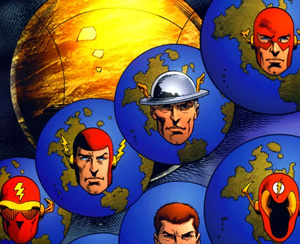Multiverse (DC Comics)
Fictional continuity construct in DC Comics
The Multiverse is a fictional continuity construct that exists in stories published by DC Comics. It refers to the collection of multiple universes within the DC Universe, each with its own version of characters, histories, and realities. The concept was first introduced in The Flash #123 (1961) in the story "Flash of Two Worlds," written by Gardner Fox and illustrated by Carmine Infantino.
History[edit | edit source]
The Multiverse concept was created to explain the existence of different versions of characters and to allow for creative storytelling possibilities. The first significant event involving the Multiverse was the crossover between the Golden Age Flash (Jay Garrick) and the Silver Age Flash (Barry Allen). This story established that the Golden Age heroes lived on Earth-Two, while the Silver Age heroes lived on Earth-One.
Crisis on Infinite Earths[edit | edit source]
The Multiverse was a central element in the 1985-1986 crossover event Crisis on Infinite Earths, written by Marv Wolfman and illustrated by George Pérez. This event aimed to streamline the complex continuity of the DC Universe by merging all the parallel universes into a single universe. The result was a unified timeline, but the concept of the Multiverse would later be revisited and reintroduced in subsequent storylines.
Post-Crisis and Infinite Crisis[edit | edit source]
After Crisis on Infinite Earths, the Multiverse was replaced by a single universe. However, the concept was reintroduced in the 2005-2006 event Infinite Crisis, which revealed that the Multiverse had been reborn, albeit in a more limited form. This event led to the creation of 52 parallel universes, each with its own unique characteristics.
The New 52 and DC Rebirth[edit | edit source]
In 2011, DC Comics launched The New 52, a publishing initiative that rebooted the continuity of the DC Universe. This included a new version of the Multiverse, which was further explored in the 2015 event Convergence. In 2016, DC Rebirth restored many elements of the pre-New 52 continuity, including aspects of the Multiverse.
Significant Universes[edit | edit source]
- Earth-One: The primary universe where the main continuity of DC Comics takes place.
- Earth-Two: Home to the Golden Age heroes, including the original Justice Society of America.
- Earth-Three: A universe where the roles of heroes and villains are reversed, featuring the Crime Syndicate of America.
- Earth-Prime: A universe that represents the "real" world, where superheroes only exist in comic books.
Impact and Legacy[edit | edit source]
The Multiverse has allowed DC Comics to explore a wide range of storytelling possibilities, including alternate histories, "what if" scenarios, and crossovers between different versions of characters. It has also provided a framework for major crossover events that have reshaped the continuity of the DC Universe.
Related Pages[edit | edit source]
- DC Universe
- Crisis on Infinite Earths
- Infinite Crisis
- The New 52
- DC Rebirth
- Justice League
- Justice Society of America
- Flash (Barry Allen)
- Flash (Jay Garrick)
Search WikiMD
Ad.Tired of being Overweight? Try W8MD's NYC physician weight loss.
Semaglutide (Ozempic / Wegovy and Tirzepatide (Mounjaro / Zepbound) available. Call 718 946 5500.
Advertise on WikiMD
|
WikiMD's Wellness Encyclopedia |
| Let Food Be Thy Medicine Medicine Thy Food - Hippocrates |
Translate this page: - East Asian
中文,
日本,
한국어,
South Asian
हिन्दी,
தமிழ்,
తెలుగు,
Urdu,
ಕನ್ನಡ,
Southeast Asian
Indonesian,
Vietnamese,
Thai,
မြန်မာဘာသာ,
বাংলা
European
español,
Deutsch,
français,
Greek,
português do Brasil,
polski,
română,
русский,
Nederlands,
norsk,
svenska,
suomi,
Italian
Middle Eastern & African
عربى,
Turkish,
Persian,
Hebrew,
Afrikaans,
isiZulu,
Kiswahili,
Other
Bulgarian,
Hungarian,
Czech,
Swedish,
മലയാളം,
मराठी,
ਪੰਜਾਬੀ,
ગુજરાતી,
Portuguese,
Ukrainian
Medical Disclaimer: WikiMD is not a substitute for professional medical advice. The information on WikiMD is provided as an information resource only, may be incorrect, outdated or misleading, and is not to be used or relied on for any diagnostic or treatment purposes. Please consult your health care provider before making any healthcare decisions or for guidance about a specific medical condition. WikiMD expressly disclaims responsibility, and shall have no liability, for any damages, loss, injury, or liability whatsoever suffered as a result of your reliance on the information contained in this site. By visiting this site you agree to the foregoing terms and conditions, which may from time to time be changed or supplemented by WikiMD. If you do not agree to the foregoing terms and conditions, you should not enter or use this site. See full disclaimer.
Credits:Most images are courtesy of Wikimedia commons, and templates, categories Wikipedia, licensed under CC BY SA or similar.
Contributors: Prab R. Tumpati, MD


